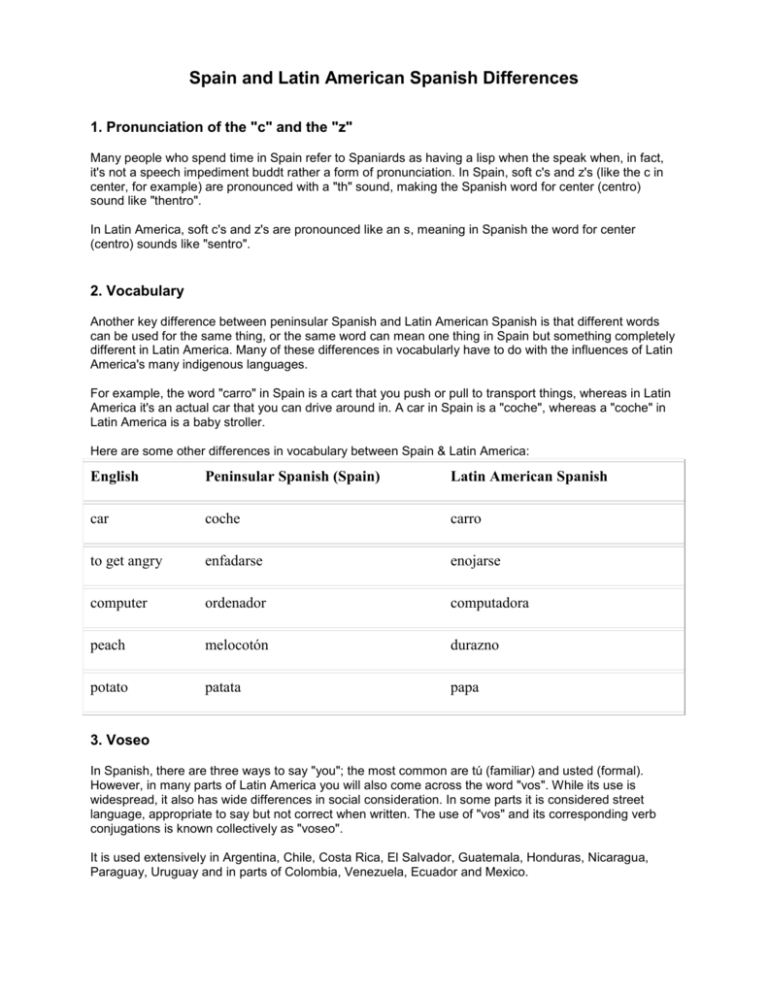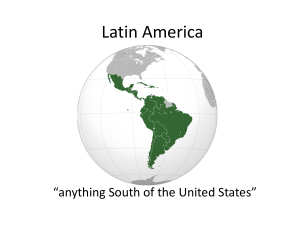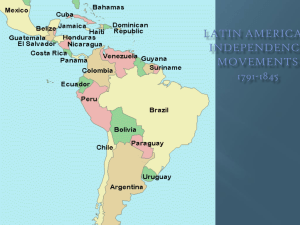Latin American and Spain Spanish Differences
advertisement

Spain and Latin American Spanish Differences 1. Pronunciation of the "c" and the "z" Many people who spend time in Spain refer to Spaniards as having a lisp when the speak when, in fact, it's not a speech impediment buddt rather a form of pronunciation. In Spain, soft c's and z's (like the c in center, for example) are pronounced with a "th" sound, making the Spanish word for center (centro) sound like "thentro". In Latin America, soft c's and z's are pronounced like an s, meaning in Spanish the word for center (centro) sounds like "sentro". 2. Vocabulary Another key difference between peninsular Spanish and Latin American Spanish is that different words can be used for the same thing, or the same word can mean one thing in Spain but something completely different in Latin America. Many of these differences in vocabularly have to do with the influences of Latin America's many indigenous languages. For example, the word "carro" in Spain is a cart that you push or pull to transport things, whereas in Latin America it's an actual car that you can drive around in. A car in Spain is a "coche", whereas a "coche" in Latin America is a baby stroller. Here are some other differences in vocabulary between Spain & Latin America: English Peninsular Spanish (Spain) Latin American Spanish car coche carro to get angry enfadarse enojarse computer ordenador computadora peach melocotón durazno potato patata papa 3. Voseo In Spanish, there are three ways to say "you"; the most common are tú (familiar) and usted (formal). However, in many parts of Latin America you will also come across the word "vos". While its use is widespread, it also has wide differences in social consideration. In some parts it is considered street language, appropriate to say but not correct when written. The use of "vos" and its corresponding verb conjugations is known collectively as "voseo". It is used extensively in Argentina, Chile, Costa Rica, El Salvador, Guatemala, Honduras, Nicaragua, Paraguay, Uruguay and in parts of Colombia, Venezuela, Ecuador and Mexico. 4. Use of "ustedes" While peninsular Spanish has two ways of saying "you" in plural form (such as when addressing a group; "you all"), Latin American Spanish has only one. In Spain, both "vosotros" (you all, informal) and "ustedes" (you all, formal) are used, while in Latin America "ustedes" is always used. This also goes for the corresponding verb conjugations. For example, we'll conjugate the verb "hablar" (to talk): Peninsular Spanish Latin American Spanish yo I hablo hablo tú you (informal) hablas hablas él, ella, usted him, her, you (formal) habla habla hablamos hablamos vosotros you all (informal) habláis X ellos, ellas, ustedes they, you all (formal) hablan hablan nosotros we So, to say "Who are you (plural) talking to?" In Spain: "¿Con quién habláis?" In Latin America: "¿Con quién hablan?"









